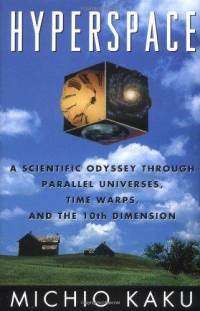Hyperspace (book)
 Cover depicting the artist's 2D conception of a 3D face of a 4D Hypercube house upon a 3D landscape. | |
| Author | Michio Kaku |
|---|---|
| Country | United States |
| Language | English |
| Genre | Popular science |
| Publisher | Oxford University Press |
Publication date | 1994 |
| Media type | Print (Hardcover) |
| ISBN | 0-19-286189-1 |
| LC Class | QC793.3.F5 K35 1994 |
| Preceded by | Beyond Einstein |
| Followed by | Visions (book) |
Hyperspace: A Scientific Odyssey Through Parallel Universes, Time Warps, and the 10th Dimension (1994, ISBN 0-19-286189-1) is a book by Michio Kaku, a theoretical physicist from the City College of New York. It focuses on Kaku's studies of higher dimensions referred to as hyperspace. The recurring theme of the book is that all four forces of the universe (the strong force, the weak force, electromagnetism and gravity) become more coherent and their description simpler in higher dimensions.
Summary
Michio Kaku tries to explain higher dimensions, first analyzing the history of higher dimensions of space and the struggle to unite quantum mechanics and general relativity in one theory. He then goes on to detail theories concerning the 2-D world, named "Flatland". The end of the book discusses such topics as wormholes, parallel universes and the fate of the universe.
Contents
Part I Entering the Fifth Dimension
- Worlds Beyond Space and Time
- Mathematicians and Mystics
- The Man Who "Saw" the Fourth Dimension
- The Secret of Light: Vibrations in the Fifth Dimension
Part II Unification in Ten Dimensions
- Quantum Heresy
- Einstein's Revenge
- Superstrings
- Signals from the Tenth Dimension
- Before Creation
Part III Wormholes: Gateways to Another Universe?
- Black Holes and Parallel Universes
- To Build a Time Machine
- Colliding Universes
Part IV Masters of Hyperspace
- Beyond the Future.
- The Fate of Universe
- Conclusion further
In popular culture
English alternative rock band Muse used the book as an inspiration for their album Origin of Symmetry.
References
- Kaku, Michio (1994). Hyperspace: A Scientific Odyssey Through Parallel Universes, Time Warps, and the Tenth Dimension. Oxford: Oxford University Press. ISBN 0-19-286189-1.
